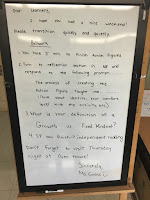We Are All Authors!
Dear Readers,
I often hear, "I stink at writing," from my 7th graders. In fact I have heard it several times this past week as we were finishing up a writing piece. I had an interesting conversation with a student. He said to me, "When I take a test I feel confident that I did well. But when I write, I always think I did bad." I responded, "I am the exact opposite. When I write I am confident I did well, but when I take tests I am not sure."
Many of our students see themselves as readers, but not necessarily writers. In the same respect, I would argue that many adults also see themselves as readers before writers. It is rare that a student will choose writing as a preferred activity, however many love to curl up in the book corner with independent reading books or browsing books.
If I want my students to see themselves as writers, I need to share my writing life with them as well. I have spent the past few years really focusing on writing instruction and looking at it through a different lens. Traditionally, my students see writing as "essays" or "research" papers. I have tried to break the mold with different skills and strategies.
Writing Is......
Whether it be a letter, a message of the day or a welcome to visitors.
We have mobile word walls of themes, character traits and transition words. The students have the freedom to get them out and use them as they need them.
Stationary Word Walls:
Depending on our writing piece and where we are in the writing process, our word walls change. Sometimes they are content specific to Language & Literature, while other times they are vocabulary specific to the theme or big idea we are studying.
Sketching:
Often I will have students sketch ideas instead of traditional writing. For example, when we watch a video clip, listen to a song or what we are visualizing when listening to a read aloud such as a text excerpt. I also incorporate Sketchnotes into my instruction instead of traditional anchor charts.
Creative Control:
Students need a place that they have designed to write in, organize and own. I give little direction on how to maintain their writer's notebooks.
Messy:
I use post-it notes as tabs in my notebooks. I tape mini-anchor charts, rubrics, examples, etc. into the notebook. I have a note section, reflection section and reading log section. I model how to draft, cross out (not erase), revise or edit. I also tell them the messier the better! The more thinking that is happening!
Mission Statements:
Writing a mission statement was not an easy task. I had to jot down ideas about myself, think about my passions, consider what is important to me in order to come up with this sentence. It was critical I had the words believe, dream, imagine, learner and positive influence.
"Language & Literature Manipulatives":
We used chart paper for the story arc, index cards to collect vocabulary, a "trunk" for artifacts, books for research/ideas, post-it notes for events/emotions/senses/etc. and lots of room to be messy!
Incorporating pop Culture into Our Lessons
Believe it or not, I used the concept of The Walking Dead to kick off our informational writing unit. We did song analysis from Wicked. Taking what students know and incorporating their lives into our classrooms increases engagement and is more authentic.
In Conclusion
Those are a few of the ways I have incorporated different genres of writing into our classroom.
A few resources I would highly recommend include......
I would also add to this list, Feedback That Moves Writers Forward by Patty McGee.
Happy writing!
Warmly,
Teresa
































No comments:
Post a Comment